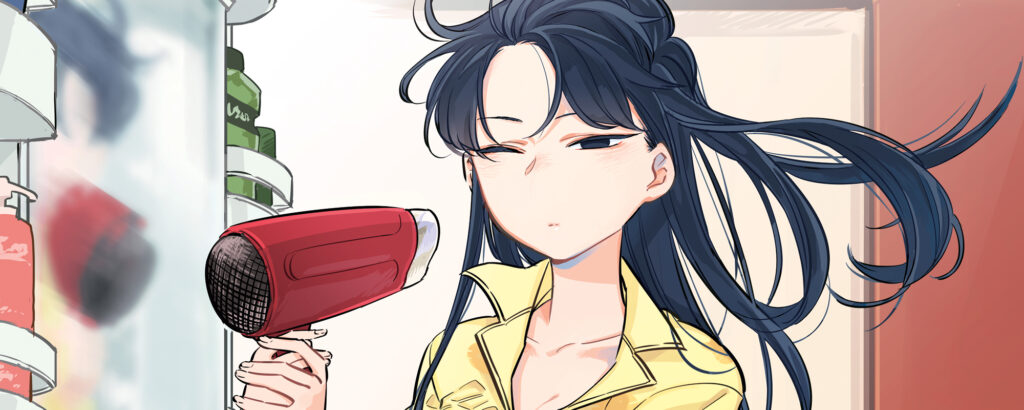
Komi Can’t Communicate is a manga by Tomohito Oda, which has been serialized in Weekly Shonen Sunday since 2016. This year, the manga has been collected in over 30 volumes, with millions of copies in circulation across the world. So, I wanted to celebrate this achievement by taking a broad look at the series as a whole.
Review At-a-Glance: Komi Can’t Communicate is a coming-of-age romantic comedy about Komi, a high school girl with social anxiety, and her first friend Tadano, an “average” high school boy who can uniquely read Komi’s idiosyncrasies. While the manga draws humor from Komi’s struggles with social interactions, it approaches this humor in a compassionate way, encouraging the reader to relate to Komi’s struggles and find triumph in her little victories. A colorful cast of quirky supporting characters both help and hinder Komi’s growth and her budding relationship with Tadano. This is a great read if you love slow-burn romance or if you like romantic comedies that lean hard into comedy.
→ Grab the first volume from our shelves and give it a try!
→ Reserve one of our Rokus to watch the anime adaptation on Netflix!
A Pleasant Surprise

I was skeptical of Komi Can’t Communicate when I opened the initial volume. I knew this manga was about Shoko Komi, a high school girl with social anxiety who dreams of making 100 friends. But that’s not how the manga starts out.
The early chapters are told from the perspective of Hitohito Tadano, an “average” high school boy, despite the fact that Komi is the person featured prominently on the cover and in the title. Komi is extremely beautiful but also very quiet, so her classmates put her up on a pedestal and don’t try to get to know her. Tadano is the first classmate to reach out to her—a great set-up for a slow-burn, friends-to-lovers story.
My concern was that the story would center Tadano’s feelings at the expense of Komi’s and that we wouldn’t get to see her inner thoughts and feelings. That’s not to say a story focused on Tadano wouldn’t have been perfectly good on its own. That just wasn’t what I signed up for when I picked up a book with Komi prominently on the cover. That, and it’s an unfortunate reality that girls are often bit players in popular manga. You can certainly find exceptions to this, but it’s common enough that I was concerned it was happening all over again. I was happy to be proven wrong.

As previously stated, Tadano is the first peer who tried to get to know Komi, leading to an achingly beautiful two-page spread that I won’t describe because the reveal hits you like a truck. Tadano’s strength as a character is that, despite his claims of being “average,” he has an almost superhuman ability to read the room. He’s extremely empathetic, and it’s through his empathy that we see Komi for the shy, lonely girl she truly is. In this way, Tadano acts as a vehicle for the empathy that permeates the story itself.
That isn’t the only way we see Komi’s character flourish, though. Within the first volume, we already have some chapters that put Komi front and center and only feature Tadano as an observer. Over the course of the series, Tadano slips more and more into the background, existing as a safety net while Komi navigates social situations. And he’s a safety net that Komi increasingly needs less as the series progresses.
After a few volumes, there are many chapters that center on Komi entirely and do not feature Tadano at all. It’s as if Komi slowly opens herself up to the audience over the course of the story, just as she slowly opens up to Tadano and the other characters around her.
An Empathetic Comedy

Empathy is this manga’s greatest strength, and as I alluded to earlier, it’s a strength exhibited through Tadano himself. He doesn’t gain Komi’s affection by being a generic “nice guy.” Instead, it’s his empathy, patience and understanding that brings the two closer together. Tadano is thoughtful and considerate, and it’s really easy to see why Komi would fall for him. If you like the kind of romance where the male lead is a dorky but cute sweetheart, then this is a good read for you.
Meanwhile, Komi is an equally compelling female lead. While much of the humor of the manga is derived from her struggles with social interactions, it’s never mocking or mean-spirited. The butt of the joke, if there even is one, tends to be society’s failure to accommodate people like Komi. Komi struggles with the opaque “rules” of social interaction. So, while people run through their usual social scripts, and Komi struggles to follow them, the rigid and often unspoken rules of social interaction make it difficult for these people to adapt.
While Komi does struggle to interact with others, she gets her little victories where she manages to convey her feelings, whether that be gratitude to a service worker or her affection for Tadano. These are framed as significant and triumphant moments, and they grow to bigger victories down the line. This is a manga that celebrates little victories in life, and I found that comforting.
Komi grows over the course of the story. Sometimes, “growth” means Komi pushing through until she accomplishes what she set out to do, and other times, “growth” is when her friends better accommodate her needs. Komi isn’t expected to “fix” herself, nor is she expected to step out of her comfort zone all by herself.
Komi predominantly “talks” to others by writing down her thoughts in a notebook, and the people around her generally roll with it, at most being momentarily perplexed upon first seeing it. Komi Can’t Communicate presents a gentle world where people may be ignorant of Komi’s special needs but are never mean or malicious (well, at least not to her—they’re mean to Tadano all the time). Seeing as a big part of social anxiety is, of course, the anxiety, I found a lot of comfort in this kind and gentle world, and it helped me believe that people in the real world could be just as kind. I think many who face the same struggles as Komi have found that same comfort and many more will continue to do so.
A Good Friend

In addition to Komi and Tadano, there’s a supporting cast of colorful and quirky characters. This is where the manga gets a little surreal, with over-the-top background characters like a student who dresses like a ninja, and an extreme narcissist who thinks he’s the main character of the manga.
The most prominent of these characters, at least for the first ten or so volumes, is Najimi Osana. She acts as a sort of sidekick to our two main characters, often getting the two lovebirds into embarrassing situations.
A middle school friend of Tadano’s, Najimi is also Komi’s second friend after Tadano. Najimi just so happens to be everyone else’s friend, too. Due to her parents frequently moving when she was young, she was the childhood friend of a lot of people, not just Tadano. But not everyone remembers her as… well, her.
Everything about Najimi’s sex and gender (her gender identity or what gender she was assigned at birth) is unknown to both the reader and the characters. Even Najimi herself expresses uncertainty at times—though, given her personality, she might be feigning ignorance to tease people. She wore a boy’s uniform when Tadano knew her in middle school, but now she’s wearing the girl’s uniform’s skirt and the necktie and blazer from the boy’s uniform. The English version of the anime adaptation even uses they/them pronouns for Najimi, though the English manga uses she/her (which I’ll be sticking with for the purposes of this blog post, seeing as it is the manga I’m predominantly talking about). In short, Najimi’s gender is both complicated and simple. She’s Najimi.
The thing that makes Najimi’s gender presentation so noteworthy is that the people around her don’t seem to care. She’s still their good friend Najimi, regardless of how they originally knew her. This obfuscation of Najimi’s gender is occasionally mined for humor, though the story seems more interested in drawing humor from Najimi behaving like a little chaos gremlin that likes to play pranks on people—a trait that is completely removed from her gender. When a joke does happen in relation to her obscure gender identity, much like with Komi’s social anxiety, the joke is more focused on the awkwardness of other people not knowing how to accommodate or categorize her. She isn’t presented as a predator, her body isn’t mocked, and no one is disgusted by her. The comedy, in my estimation, is never punching down at Najimi or real-life gender non-conforming or genderqueer people. It’s empathetic humor, similar to how Komi’s social anxiety is handled, though admittedly with a few more slip-ups by comparison.
That’s what I find delightful about Komi Can’t Communicate. The empathy that I keep coming back to isn’t limited to our two main characters but extends to the supporting cast, as well. Many of Komi’s triumphs come from welcoming people who are similarly misunderstood, such as with an awkward goth girl in her class, or a different girl with anger issues. Komi may seem cold and distant, but she cares. She cares a lot. And through her and Tadano, the story cares.
A Kind World

Komi Can’t Communicate doesn’t always perfectly thread the needle in regards to its comedy, but its efforts toward empathetic humor, finding the absurdity in the situation without mocking those involved, are largely successful and wholly admirable.
This manga presents a world that cares and is doing its best to be kind. And at the center of that world is a touching coming-of-age story, coinciding with an adorable slow-burn romance and a heavy dose of comedy.
I found comfort in this story. I hope you will, too.
